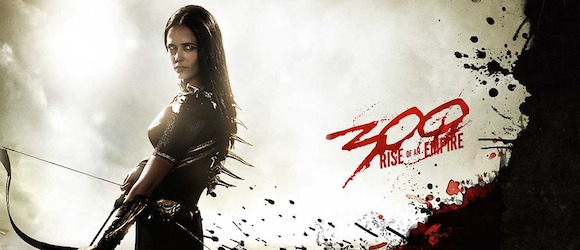Do we make movies a certain way because we think it’s what an audience wants to see? Is it right to choose your audience before your film is released, and damn whoever else dares to watch it? These questions were the ones causing the headache that followed my viewing of 300: Rise of an Empire. A sea of machismo and crimson gushing, 300:Rise of an Empire is a high-camp successor to the much lauded 300, the highly fictionalized tale of the three hundred Spartan warriors who stood their ground against an insurmountable force at the Hot Gates. (Still not as good as the Samurai Jack episode featuring the Spartan 300, the bar by which all representations of the Battle of Thermopylae should be judged, robot minotaurs and all.) More of a straightforward war story, 300:RoaE lacks the degree of self-importance its predecessor had. Yet for all its bombast and innovative gore, 300:RoaE is a picture that has no problem excluding part of its potential viewership. It may know exactly what it is, but it never tries to move one inch beyond the expected.
Bloody, messy spoilers beyond the cut.
300: RoaE takes place before, around, and after the events of 300, which is recapped in brief as a piece that, while necessary to the final action, does not require too much detail. Narrated by a seemingly omnipotent Queen Gorgo (a returning Lena Headey), 300:RoaE concerns itself with the Greek opposition to invading tyrant Xerxes, starting with the killing of King Darius by Athenian hero Themistocles (Sullivan Stapleton), and leading on through Darius’ son Xerxes’ rise to power at the hands of the manipulative, brilliant navy commander Artemisia (Eva Green, scenery chewing in a succession of fabulous Alexandra Byrne outfits). The lion’s share of the film is series of creative naval battles between main baddie Artemisia’s impressive fleet and Themistocles’ “patchwork of ships”, as our protagonist tries to buy enough time for the Greek city-states –including a reluctant Sparta- to get their act together and join forces.
But no one is here for the Frank Miller version of playing fast and loose with history. You want action, big, bloody action, and 300:RoaE certainly delivers in deaths both classic and unusual. Heads cleaved in half, men lit on fire as suicide bombers, or drowned by their fanatical leader; the film has it all and then some. I found myself with the odd technical complaint that most of the blood looked too CG-created, being too dark, thick, and gelatinous, and that some more practical effects could have really livened up the place. But 300:RoaE is, perhaps thankfully, unconcerned with any kind of realism, a trait that leaks straight through to the dramatic narrative. There’s plenty of standing on rock formations and making speeches about decisions on the battlefield, but no one seems to be taking themselves nearly so seriously about it all as they did in 300. Though some may miss that near-mythic resonance of events, I was among those who found it wearisome in 300, and was glad of its scarcity here.
Having set pieces just because you think they need to be there, even when they don’t fit, can result in some head-scratching among viewers. At least, I found myself head-scratching a bit when it came to a scene of what ‘fic writers would call hate sex between Artemisia and Themistocles. The surface of the scene is that, recognizing a true equal, Artemisia tries to seductively persuade Mr. Athens to change sides and fight alongside her. A classic, if out of character, “we’re not so different, you and I”, the scene dissolves rapidly into vigorous intercourse. Besides providing an obligatory note of sexuality in a blood-soaked war film (as though all the tight togas and gleaming pecs weren’t enough), this scene serves two other purposes. One is to assert the red-blooded heterosexuality of an otherwise ambiguous hero who doesn’t have a wife and claims his only real loves are his country and the fleet. The other purpose, and, perhaps the main subconscious need for the scene, is to assure a presumed male audience that might be threatened by Artemisia’s autonomy, ferocity, and competence that she is still DTF, specifically their stand-in character.
If it’s one thing besides blood that really fills up the screentime in 300:RoaE, it’s finding ways to devaluate the presence of a bold female character, or of women in general. All ready as I was to settle in and enjoy some bloody nonsense for two hours, I can’t say I was surprised at the heaping amount of rape and implied rape that mars an otherwise perfectly ridiculous feature. In what might be the second main shot of the entire film, a topless woman is hauled off by two soldiers. There are several other instances like this throughout the film, as well as a visual representation of what happened to young Artemisia’s family (rape and murder, not in that order), and a hard cut out of a scene in which a disrobing man approaches a chained-up young girl. The too-often-heard argument that, say, rape is a realistic consequence of war holds no water here, where, in a land of CGI guts, glory, disfigurements, and costumes aping Alexander McQueen, realism is the farthest point of concern. I’ve never, ever heard, and would dare anyone to say, that they’ve left a film thinking that a scene of rape or implied rape was missed from a film’s proceedings, that they expected it to be there and it wasn’t. Rape is supposed to be shorthand for the brutality of the ancient world, but, given the raging violence of the entire rest of the film, it comes across as gratuitous.
The over-use of rape as a device comes to a head where Eva Green’s character is concerned. Her story is that, her family murdered and herself captured by the same soldiers, she is held for years, under heavy physical abuse, before being discarded onto the streets. There she is found by a Persian messenger (Peter Mensah), and trained in the arts of combat. Needless to say, the trope of the raped or otherwise assailed girl who goes on to become a warrior is tired, old, and overdone. Among other problems, it serves the message that women are not naturally prone to war, or competency in battle, but have to become that way through suffering, through being a victim of one kind or another. Our hero, Themistocles, needs no such explanation for his warrior prowess; he simply is inclined towards a soldier’s life, and has worked to be the best. We, as an audience, are trained to accept a male character’s thirst for battle, but are presumed to need a traumatized backstory to explain why a woman would do the same. Queen Gorgo fares quite a bit better in this regard, but it is the vengeance she seeks as a widow, not her initial identity as a Spartan, that spurs her into action at the film’s end.
300:RoaE is a movie willing to alienate part of its prospective audience to appeal to its perceived one. I came to be entertained, and I was, but at the expense of my gender. While I can appreciate a film that is aware of itself, I wish it wasn’t hampered by the ill-conceived business plan to cater to the assumed fantasies of its target viewership. Ill-conceived because I’ve never seen or heard of a film that made less money by being more inclusive. Equality in slaughter is fine by me, as men and women alike get hacked up in 300:RoaE, in endless slow-motion/fast-motion battle sequences. But claiming an explanation is needed for the participation of women in all this bloody fun? Now that’s going too far.









Published: Mar 10, 2014 11:05 am